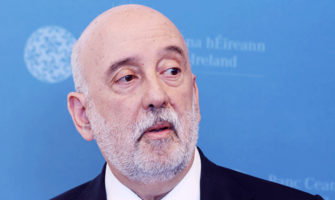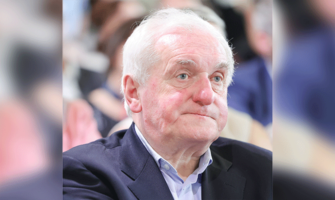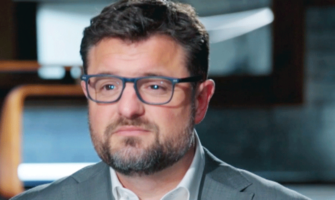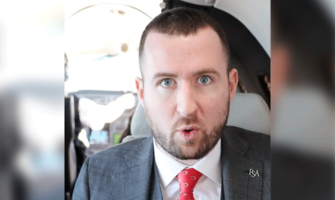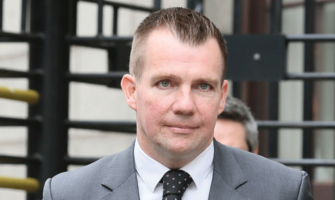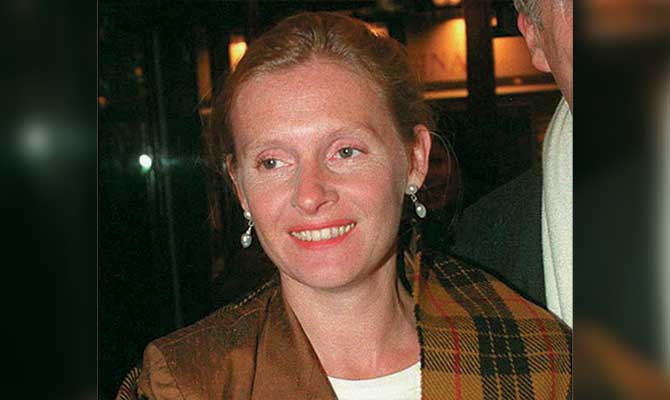
Sophie Toscan du Plantier
Sam Bungey (along with Jennifer Forde) created the 2018 13-episode ‘West Cork’ podcast on the Sophie Toscan du Plantier murder, which is Audible’s most listened to podcast ever.
The saga of Ian Bailey has taught us this: should you ever find yourself subject to trial-by-media, the very worst thing you can do is to drop dead.
My wife Jennifer Forde and I got to know Bailey over many years while making a podcast called ‘West Cork’. When he collapsed from a heart attack last Sunday afternoon, we were asked by many media organisations to offer up any damning titbits we might have left out to spare Bailey’s blushes. Most pressingly, now he was dead, could we now say, ‘did he do it?’ Others were already answering that question.
“I never had any doubt that he and he alone killed Sophie Toscan du Plantier,” proclaimed one reporter the morning after his death. Another recalled staring into Ian’s eyes and finding the unflinching coldness of a “functioning psychopath”.
Meanwhile, there were fresh allegations – that Bailey held vigils at the home of serial murderers Fred and Rosemary West and that, again allegedly, he had once been wanted by UK police, where he was from, for forging his wife’s signature on a life insurance policy.
Frankly, this was thin gruel compared to things Bailey read about himself while he was still alive. Over the years it has been variously reported that: he ran pagan-themed full moon beach parties with lesbians; that he slept naked on hillsides; that he liked to rub himself all over with pig excrement; that he used beat his wife; that he was seen washing his wellington boots in a stream near Sophie Toscan du Plantier’s house the night she was murdered. Most of these stories, including some which had been originally supplied by the gardai, are now established as false.
The truth is journalists never really had to pull their punches with Bailey. The trick would be to call him up and put the accusation to him directly. Bailey was always reachable. Hell, he might hear you were working on something and call you up himself. And he would find a way to breathe life into the thinnest story.
His quotes fizzed with his peculiar brand of arrogance, unreliability, and awkward humour. Confused about how to act in the glare of public scrutiny, Bailey would seldom show sympathy for Sophie’s family. He fumbled loaded questions about what should happen to Sophie’s killer. Reporters noted that he rarely mentioned Sophie herself, and then only by her last name. When he did use her first name, that was somehow sinister, too.
Through more than two decades of practice, Bailey never managed to sound truly repentant about the brutal violence he had visited on his partner, Jules Thomas.
And he kept talking and talking. In an age before social media, he was in a co-dependent relationship with a press that was in complete control of his dopamine receptors.
At the slightest encouragement, Bailey could be moved to discuss his uncommon intelligence and unlimited sexual prowess. He offered the material to write the perfect villain and it was irresistible.
When he tried to escape the crucible of suspicion in West Cork, eventually transforming into a semi-recluse, Bailey came to rely on journalists for company. Though he respected the transactional nature of the relationship, often it seemed he just wanted to speak to someone. He sat for dozens of hours of interviews with us. After we stopped recording, he would often find some way to extend the visit, labouring over a pot of coffee or yet again conducting a tour of the garden, showing us a freshly dug hole or some other recent evidence of toil, though it became clear that Thomas, then still his partner, was doing most of the work.
When ‘West Cork’ came out Bailey spoke with delight of becoming known to a younger generation. Then came the streaming wars. One day at the market, a squabble broke out between two rival documentary teams both wanting to film Bailey at his stall. Bailey, in the middle of that scene, must have been euphoric. The next day, chasing the high, he tipped off a reporter at a national newspaper about the clash.
Bailey regularly passed on story ideas. When Sophie’s neighbour Alfie Lyons died and his widow Shirley Foster put the house up for sale, Ian sent the local real estate listing to a contact in the tabloids, leading to the headline: “Neighbour who found the body of Sophie Toscan du Plantier puts home on the market.” As a former reporter, Bailey got a vicarious thrill from these interactions. He also considered it smart practice – after all, such offerings might lead to favourable coverage down the line.
Publicly, Bailey blamed his heart disease on the years of hounding from the gardai. In fact, he rather suspected it was the covid vaccine, whatever the doctors had to say about his addiction to alcohol and cigarettes. In any case, he later told me he had decided he might as well talk about it and “play it as a f––g card”.
Bailey fancied himself a shrewd manipulator of the media when in fact he was hopelessly naive. Again and again he found himself effortlessly outmanoeuvred.
When he was charged in France, Bailey received a file containing much of the evidence the guards had assembled against him. His reaction was to immediately farm the file out to half a dozen journalists. Others requested their own copies, offering to use the material to write books that would exonerate him. When Bailey offered the file to them too, they buried him.
On Monday, one such author, the Belgium-based writer Nick Foster, told Newstalk that members of the public would likely share his certainty over Bailey’s guilt if they enjoyed his access to the details of the case. On the contrary, one detective working this case told us he has never seen such a compromised investigation in his life: “It’s like, the whole thing is in the public domain,” he said.
Foster and others attracted a band of online fan-boys and girls. They constructed convoluted theories on group chats and shared them with the authors on social media. Using anonymous handles they badgered Bailey, sending him DMs and emails and posting surreptitiously-taken photos of Bailey around West Cork looking drunk and decrepit. They spoke of leafleting Bantry with damning information and of confronting him in person. They claimed he had soiled himself in a Bantry pizzeria. They called him a paedophile, a ‘local pervert’ and a ‘waste of skin’.
On the pervert charge at least they had a point. Bailey used social media to leave lewd messages under racy photos of young women, many of whom were clearly bot accounts. Sometimes he would share his mobile number. One night, he said he left his flat to meet two young women he interacted with on Facebook but male acquaintances of these women appeared, kicked away his walking stick and beat him while he lay on the ground outside his flat.
By then it had been more than a year since Jules Thomas had ended her relationship with Bailey. On Sunday, Thomas reacted to his death by saying, “I feel nothing. He is not in my thoughts.” The reporter asked an age-old follow up: did she believe Ian was innocent? “It is not a question of belief.” Thomas replied. “I knew he couldn’t have done it.”
Thomas’ reflections recalled a conversation we once had with one of her daughters by the back door of the Prairie cottage.
“I cannot stand him,” she said casually, gesturing towards Bailey, who was comfortably in earshot. She had wanted Bailey out of her mother’s life for years – hating him for the brutal violence he had inflicted on her. But she didn’t believe he was a murderer.
Rather than assess the man and the murder separately, the media spoke about Bailey’s personal shortcomings and evidence of his guilt almost interchangeably. One columnist ended a diatribe against Bailey with a wave-of-the-hand dismissal:
“Whether he was guilty of murder or not,” Bailey was “a wretched human being”. Reflections on his love of the limelight continued to pile up even as his remains were sent from the Bantry morgue and to a Cork city crematorium.
“How self-sabotage ended Ian’s Bailey’s hopes of innocence,” ran one headline. It was a strange and perhaps revealing formulation. Apparently innocence was not merely a question of having nothing to do with Sophie’s murder. To be innocent, Bailey would have to have done something about all that ‘self-sabotage’, too.
Last week in France, the case was described as a ‘source of eternal shame’ for Ireland. This is meant in the sense that Ireland failed to convict Ian Bailey – the gardai and the state pathologist fumbled evidence collection, and the DPP lacked the courage to put him on trial.
But the former DPP James Hamilton believes the shame lies with the guards for their decision to hand over documents to France, which were used to convict Ian in absentia and without a lawyer present. In so doing, Hamilton says, the guards undermined Irish justice.
If there is shame hanging over the DPP’s past as an institution, it is to do with communication. They received plaintive letters from Sophie’s mother and son begging to understand why Ian was not being prosecuted, and for more than a decade they offered them next to nothing by way of explanation. Only when the DPP was bigfooted by its French counterparts did Hamilton take the unprecedented step of arranging the release of an internal document analysing the garda investigation.
The DPP was not ordering the garda to go look for an alternative suspect to Ian. Unlike French inquiring magistrates, the DPP does not direct investigations. It must have seemed to Sophie’s family like an act of mystifying cruelty that the DPP was apparently content to leave it there.
As it finally emerged, the DPP office had uncovered a series of unsafe practices in the garda investigation, believing that multiple key witnesses were “at the very least” unreliable, and suspecting that some had been influenced by an atmosphere of hysteria they had created in West Cork.
Many people who have followed this case over the years have some particular piece of evidence that has left them convinced of Bailey’s guilt. But in each case, the context of how and when this evidence was gathered is crucial. That context, as former DPP Eamonn Barnes put it, is a “thoroughly flawed” and “prejudiced” investigation.
The DPP’s refusal to charge Bailey is sometimes put down to the prejudiced attitude of a single, overzealous case officer who wrote the damning analysis released to the public. In fact, two DPPs scrutinised this case, with their teams of lawyers, over some eleven years and concluded the evidence did not warrant prosecution.
Secretly recorded phone calls revealed that the Garda bookman Detective Superintendent Liam Hogan had rather agreed with the DPPs estimation of their case.
“All we have is very weak circumstantial evidence,” Hogan said. He felt all they had against Bailey was a bunch of “threads”. On the other end of the line, a fellow detective concurred: “‘Yeah, yeah, yeah, I know. T’is flimsy like.”
Journalist Senan Molony was plagued by no such doubts.
“Bailey, who had been drinking all night, went to Sophie’s door seeking sex,” Molony wrote in The Independent last Monday. The following day, Nick Foster picked things up: “Bailey bludgeoned Sophie to death. He repeatedly struck Sophie’s face with a rock.”
There is a certain thrill in this, familiar to school children who have goaded each other into shouting swear words from the back of the class, but at such moments it is worth remembering the role the media has played in making this case the disaster it is.
















